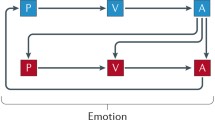Abstract
While classical theories systematically opposed emotion and cognition, suggesting that emotions perturbed the normal functioning of the rational thought, recent progress in neuroscience highlights on the contrary that emotional processes are at the core of cognitive processes, directing attention to emotionally-relevant stimuli, favoring the memorization of external events, valuating the association between an action and its consequences, biasing decision making by allowing to compare the motivational value of different goals and, more generally, guiding behavior towards fulfilling the needs of the organism. This article first proposes an overview of the brain areas involved in the emotional modulation of behavior and suggests a functional architecture allowing to perform efficient decision making. It then reviews a series of biologically-inspired computational models of emotion dealing with behavioral tasks like classical conditioning and decision making, which highlight the computational mechanisms involved in emotional behavior. It underlines the importance of embodied cognition in artificial intelligence, as emotional processing is at the core of the cognitive computations deciding which behavior is more appropriate for the agent.


Similar content being viewed by others
Notes
Classical conditioning (or Pavlovian conditioning) is the learned pairing of an unconditioned stimulus (US, e.g. food) that produces an unconditioned response (UR, e.g. salivation) with a conditioned stimulus (CS, e.g. a bell) presented a certain amount of time before the US. After sufficient learning, the appearance of the CS produces a conditioned response (CR) that is similar to the UR.
Reversal learning is a form of operant conditioning where the consequences of two well-learned actions are reversed: if the action A systematically led to reward and B to punishment, the experimenters look how fast the animal adapts its behavior when A suddenly leads to punishment and B to reward.
Extinction learning is a form of classical conditioning where a learned CS is no longer associated to an US (or an action to it outcome).
Random dots discrimination task consists in the visual presentation of an array of randomly moving dots, biased on average towards a particular direction (e.g. left or right). The subject has to guess this direction of movement. Reaction times typically increase with the difficulty (or uncertainty) of the task.
References
Armony JL, Servan-Schreiber D, Cohen JD, Ledoux JE (1997) Computational modeling of emotion: explorations through the anatomy and physiology of fear conditioning. Trends Cogn Sci 1(1):28–34
Bach J (2009) Principles of synthetic intelligence PSI: an architecture of motivated cognition. Oxford University Press, Oxford
Balleine BW, Liljeholm M, Ostlund SB (2009) The integrative function of the basal ganglia in instrumental conditioning. Behav Brain Res 199(1):43–52
Bastiaansen JACJ, Thioux M, Keysers C (2009) Evidence for mirror systems in emotions. Philos Trans R Soc Lond B, Biol Sci 364(1528):2391–2404
Bechara A, Damasio H, Damasio AR (2000) Emotion, decision making and the orbitofrontal cortex. Cereb Cortex 10(3):295–307
Becker-Asano C, Wachsmuth I (2010) Affective computing with primary and secondary emotions in a virtual human. Auton Agents Multi-Agent Syst 20(1):32–49
Brown J, Bullock D, Grossberg S (1999) How the basal ganglia use parallel excitatory and inhibitory learning pathways to selectively respond to unexpected rewarding cues. J Neurosci 19(23):10 502–10 511
Cahill L, Babinsky R, Markowitsch HJ, McGaugh JL (1995) The amygdala and emotional memory. Nature 377(6547):295–296
Chib VS, Rangel A, Shimojo S, O’Doherty JP (2009) Evidence for a common representation of decision values for dissimilar goods in human ventromedial prefrontal cortex. J Neurosci 29(39):12315–12320
Daw ND, Niv Y, Dayan P (2005) Uncertainty-based competition between prefrontal and dorsolateral striatal systems for behavioral control. Nat Neurosci 8(12):1704–1711
Deco G, Rolls ET (2005) Synaptic and spiking dynamics underlying reward reversal in the orbitofrontal cortex. Cereb Cortex 15(1):15–30
Dranias MR, Grossberg S, Bullock D (2008) Dopaminergic and non-dopaminergic value systems in conditioning and outcome-specific revaluation. Brain Res 1238:239–287
Frank MJ, Claus ED (2006) Anatomy of a decision: striato-orbitofrontal interactions in reinforcement learning, decision making, and reversal. Psychol Rev 113(2):300–326
Grossberg S (1971) On the dynamics of operant conditioning. J Theor Biol 33(2):225–255
Grossberg S (1972) A neural theory of punishment and avoidance, i: Qualitative theory. Math Biosci 15:39–67
Grossberg S, Levine DS (1987) Neural dynamics of attentionally modulated Pavlovian conditioning: blocking, interstimulus interval, and secondary reinforcement. Appl Opt 26(23):5015–5030
Grossberg S, Seidman D (2006) Neural dynamics of autistic behaviors: cognitive, emotional, and timing substrates. Psychol Rev 113(3):483–525
Haber S (2008) Parallel and integrative processing through the basal ganglia reward circuit: lessons from addiction. Biol Psychiatry 64(3):173–174
Humphries MD, Prescott TJ (2010) The ventral basal ganglia, a selection mechanism at the crossroads of space, strategy, and reward. Prog Neurobiol 90(4):385–417
Koenigs M, Grafman J (2009) Posttraumatic stress disorder: the role of medial prefrontal cortex and amygdala. Neuroscientist 15(5):540–548
Lazarus RS (1999) The cognition-emotion debate: A bit of history. In: Dalgleish T, Power MJ (eds) Handbook of cognition and emotion. Wiley, New York, pp 3–19
LeDoux J (2003) The emotional brain, fear, and the amygdala. Cell Mol Neurobiol 23(4–5):727–738
Levine DS (2007) Neural network modeling of emotion. Phys Life Rev 4(1):37–63
Murray EA (2007) The amygdala, reward and emotion. Trends Cogn Sci 11(11):489–497
Ochsner KN, Gross JJ (2005) The cognitive control of emotion. Trends Cogn Sci 9(5):242–249
Ohman A, Flykt A, Esteves F (2001) Emotion drives attention: detecting the snake in the grass. J Exp Psychol Gen 130(3):466–478
Ono T, Nakamura K, Nishijo H, Fukuda M (1986) Hypothalamic neuron involvement in integration of reward, aversion, and cue signals. J Neurophysiol 56(1):63–79
O’Reilly RC, Frank MJ, Hazy TE, Watz B (2007) Pvlv: the primary value and learned value Pavlovian learning algorithm. Behav Neurosci 121(1):31–49
Picard R (ed) (1997) Affective Computing. MIT Press, Cambridge
Rao RPN (2010) Decision making under uncertainty: a neural model based on partially observable Markov decision processes. Front Comput Neurosci 4:146
Rescorla RA, Wagner AR (1972) A theory of Pavlovian conditioning: Variation in the effectiveness of reinforcement and non-reinforcement. In: Black AH, Prokasy WF (eds) Classical Conditioning II: Theory and Research. Appleton Century Crofts, New York
Richter-Levin G (2004) The amygdala, the hippocampus, and emotional modulation of memory. Neuroscientist 10(1):31–39
Roesch MR, Olson CR (2004) Neuronal activity related to reward value and motivation in primate frontal cortex. Science 304(5668):307–310
Scherer KR, Shorr A, Johnstone T (eds) (2001) Appraisal processes in emotion: theory, methods, research. Oxford University Press, Canary
Schmajuk NA, DiCarlo JJ (1992) Stimulus configuration, classical conditioning, and hippocampal function. Psychol Rev 99(2):268–305
Schultz W, Dayan P, Montague PR (1997) A neural substrate of prediction and reward. Science 275(5306):1593–1599
Suri RE, Schultz W (2001) Temporal difference model reproduces anticipatory neural activity. Neural Comput 13(4):841–862
Sutton RS, Barto AG (1981) Toward a modern theory of adaptive networks: expectation and prediction. Psychol Rev 88(2):135–170
Sutton RS, Barto AG (1998) Reinforcement learning: an introduction. MIT Press, Cambridge. A Bradford Book
Takahashi YK, Roesch MR, Stalnaker TA, Haney RZ, Calu DJ, Taylor AR, Burke KA, Schoenbaum G (2009) The orbitofrontal cortex and ventral tegmental area are necessary for learning from unexpected outcomes. Neuron 62(2):269–280
Vitay J, Fix J, Beuth F, Schroll H, Hamker FH (2009) Biological models of reinforcement learning. Künstl Intell 3:12–18
Vitay J, Hamker FH (2010) A computational model of basal ganglia and its role in memory retrieval in rewarded visual memory tasks. Front Comput Neurosci 4:1–18
Vuilleumier P (2005) How brains beware: neural mechanisms of emotional attention. Trends Cogn Sci 9(12):585–594
Ziemke T (2008) On the role of emotion in biological and robotic autonomy. Biosystems 91:401–408
Acknowledgements
The authors are in part supported by the German research foundation (Deutsche Forschungsgemeinschaft) grant (DFG HA2630/4-2) “The cognitive control of visual perception and action selection”.
Author information
Authors and Affiliations
Corresponding author
Rights and permissions
About this article
Cite this article
Vitay, J., Hamker, F.H. A Neuroscientific View on the Role of Emotions in Behaving Cognitive Agents. Künstl Intell 25, 235–244 (2011). https://doi.org/10.1007/s13218-011-0106-y
Received:
Accepted:
Published:
Issue Date:
DOI: https://doi.org/10.1007/s13218-011-0106-y




